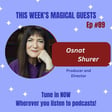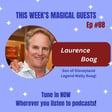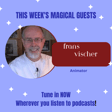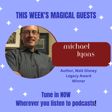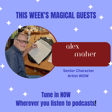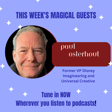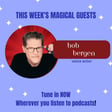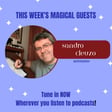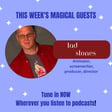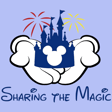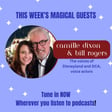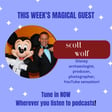Become a Creator today!Start creating today - Share your story with the world!
Start for free
00:00:00
00:00:01

Episode 68: Tom Sito
This week, the Sharing the Magic crew chats with award-winning animator Tom Sito! Having worked on projects ranging from the animated series He-Man and the Masters of the Universe to disney classics like Lion King, Tom shares many amazing stories from his legendary career!
For more about Tom check out his website HERE
DISCLAIMER: We are not an affiliate of the Walt Disney Company nor do we speak for the brand or the company. Any and all Disney-owned audio, characters, and likenesses are their property and theirs alone.
Recommended
Transcript
Introduction to 'Sharing the Magic' and Hosts
00:00:02
Speaker
Welcome to Sharing the Magic, the podcast that takes you on a journey through the enchanting worlds of Disney. Each week, we're joined by a special guest, whether they're a magician creating moments of astonishment or a Disney expert sharing the secrets behind the magic of the happiest place on Earth. Together we'll uncover the stories, inspirations, and behind the scenes tales that bring these worlds to life. So, get ready to be spellbound and transported to a place where dreams come true.
00:00:50
Speaker
yeah
00:00:54
Speaker
Hello again, friends, and welcome to another great edition of the Sharing the Magic podcast. I am your host tonight, James Kemp. i' I'm so excited about tonight's guest, but before we get into our guest, let's introduce our cast tonight. Let's start off with Lisa. Lisa, how are you doing?
00:01:10
Speaker
I am great. I'm enjoying our nice, cool weather here in Indianapolis at 70 degrees, just preparing for our Walt Disney World trip in a couple of weeks. So I'm so excited to hear from our guest today. He's had his fingerprints on many different projects throughout the years. I'm so excited. Me too. I'm i'm really excited. There's a lot of projects
Tom Sito's Animation Journey Begins
00:01:34
Speaker
I'm excited to talk about. Now, Dawn, you just got back from that wonderful place that we call Disney World. How are you doing today?
00:01:39
Speaker
Yes, it took me a little bit to recover from the vacation in that typical. I think I walked like eight miles a day. We had one day we went to the Springs and Wachova Springs. Is that what it's called? Wakiva Springs. ah Beautiful. And it was a really nice um change from the heat because it the water was like, I think 72 degrees. So yeah, that's really cold for water. So, but we had a great day. So yeah.
00:02:07
Speaker
I'm from Houston, and nice to ah meet you. Can't wait to hear everything that we talk about on the show today. Up next, we're going to jump to Tara. Tara, how are you doing? I'm doing great. Everything's good over here. I'm looking forward to interviewing our guest tonight. All right, Brian. Well, I guess you're up, my friend.
00:02:27
Speaker
Hello, I'm Brian Galloway here. I'm really excited about, again, I am excited too. And I'm excited not to ask about Simba the White Lion, which cracked me up. Anyway, um I'm here from the Jersey Shore where we're winding down our our summer. It's still nice out and we're still enjoying the beach when we can. Awesome. And now, as many of you are may have picked up, we have a great Disney animator here. Just many, many stories and many adventures through our lives that he's been a part of.
00:02:56
Speaker
And that would be Mr. Tom Saito. How are you doing today, Tom? OK, very good. Very good. Sito is the right pronunciation. I want to make sure I got that right. I'm sorry about that. No problem. So, at Lisa, I'm going to start us off with asking Tom the questions. All right. So when we interrupt for you, our guests, we always like to ask where or how did you develop your love for Disney? How did you get started?
00:03:23
Speaker
Well, let's see. um I was you know raised in in New York City. um I was born and raised in Brooklyn before it was cool when it was a dump. And it is cool. that It's so funny how it is cool now, you're right. Yeah, I know. It's so funny being told by people, oh, your neighborhood's not what it used to be. Oh, it's not that. the Now it's like your neighborhood is too hip for you.
00:03:46
Speaker
like Okay, thank you. That's great. But ah I guess I always loved cartoons, and of course Disney's was like the ultimate. I think of the first Disney film I saw was, ah um which was probably Sleeping Beauty, I think in the theaters, and then Sword in the Stone.
00:04:03
Speaker
And um I found I could draw. and And, you know, originally, originally I was thinking of doing newspaper cartoons because in the 60s that was the big game and New York City was was was newspapers. So everybody wanted to be the next Al Cap or Charles Schultz or something. And the idea of going to Hollywood was like going to the moon. yeah You know, it was like it was like so either out of my realm of experience.
00:04:27
Speaker
But in in high school, a teacher showed me how to do animation, and I and i fell in love with it. And then I found out I could make a living doing it. And I was kind of fortunate that when I began my career, I made the acquaintance of ah Richard Williams, who was the ah directing animator on Who Framed Roger Rabbit, you know the animation director. And Dick had ah had a style, and this is like around 1976, of a lot of young people like me just starting in the industry.
00:04:59
Speaker
He liked to pair us up with older animators who were retiring because they really saw the generational shift at that point where it's like the the golden age animators who did Snow White and Pinocchio and all. They were retiring and kids like me were coming in and we had a chance to overlap. So I had a chance to work with a guy named Seamus Colhane who was an animator on the High Ho March.
00:05:23
Speaker
and he does some Honest John and Pinocchio. And and you know I got to know a number of people. Well, ah you know I got to know Art Babbitt, who's the ah animator who created Goofy and the Wicked Queen and Snow White. And it was wonderful because they were they were so giving with their information and all. And and it was just very exciting.
Early Animation Projects and Industry Shifts
00:05:43
Speaker
you know and And then after that, it's like, OK, this is what I want to do. oh What great mentors that that you had, I mean, some of those names, ah Disney history, um how awesome. What was your first animation project, whether Disney or not?
00:06:05
Speaker
Well, I'd say the very first one, like next year, it'll be 50 years, was ah was of ah and a nutrition film for for preschoolers. ah but and So it's called Let's Hippity Hop to Nutrition Land. I have not heard of that. I'll have to look that up. Can we find it somewhere? ah God knows. I don't know.
00:06:29
Speaker
I love that, though. It's a great, and great name. Yeah, you know, and then um and then the the the film with Richard Williams was called The Adventures of Raggedy Ann and an Andy 1977. It was written. The music was all written by Joe Raposo, who wrote all the music for Sesame Street.
00:06:47
Speaker
So he wrote, you know, can you tell me how to get how to get to Sesame Street? You know, you know, all that stuff. And and it was kind of like a musical sort of anticipating what our big musicals of the 90s would be like, because it was a pairing of Broadway and animation. ah Although the the the story was kind of weak, you know, unfortunately. And but there's a lot of ah a lot of great effort at it. you know You know, there's a lot of like really good people working on it. So, you know, I learned a great deal from it afterwards.
00:07:17
Speaker
You've already covered a lot of my childhood. A lot of my first movies that I've watched. um and i And I noticed our viewers can't see in your background, but you have, you didn't mention who frames Roger Rabbit. And we did have Gary Wolf on the podcast a few months ago, which was which was a wonderful time. We went way over time. He has lots of stories. So, um I can't wait to hear some more, but I won't ask all of the questions tonight. We will share in the wealth of questions. Before we get to Disney, though, i I was looking today and Super Friends was a bit before my time, but the Hanna-Barbera stuff and also going into doing He-Man and Masters of the Universe. I mean, you got to animate some of the greatest superheroes
00:08:08
Speaker
known demand. What was that like? I mean, Super Friends and all in itself, and then He-Man, I mean, that that's an 80s kid's dream, 80s, 90s kid's dream just to watch that overall now, you know, talking to someone who animated. What was that like, creating in that process? Because I know that the process overall behind He-Man was a bit of a tough process to even get it to the screen.
00:08:27
Speaker
isn isn yeah it Yeah, it was a lot of fun working on on those series. I moved out to Hollywood and and ah in and I got a job working at Hanna-Barbera. And Hanna-Barbera was still like very big. it was like They were doing like 12 series at once and all.
00:08:46
Speaker
and um including super friends. And it was kind of fascinating because again, with that with that shift of generations with a lot of the older animators like and and you know, ah like ah doing their last work before they retired, Hannah Barbera was kind of like a lifeboat for all these guys, you know.
00:09:05
Speaker
yeah So you just walk down the aisle, you know, you walk through the hallway and go, there's ah Dave Tenler, who was an animator on Popeye. And there's Kaz Anzalade, he used to work on for Ralph Bakshi on Fritz the Cat. And there's Nick Nichols, who was the director on Disney shorts. You know, we um you know had John Kimball, who was like Ward Kimball's son.
00:09:26
Speaker
and And, of course, for his frailing and ah even even lurched that, you know, Ted Cassidy from from the Adams family, he would come in and do voices and all. And it's very nice, but a huge man, you know. like But ah you know it was just fascinating just to to to to be able to interact with all with all these folks.
Success of 'He-Man' and Animation in the 80s
00:09:49
Speaker
And know and and then ah yeah later on in the 80s, a few years later in the 80s, we were doing the He-Man show. and And I remember it was sort of kind of a fluke in a way because ah I had been unemployed for a little while and I was happy to get to work.
00:10:03
Speaker
And and you know the story, my first week, i so I turned to the guy next to me and said, the name of this show isn't really He-Man, right? that's like ah That's like a temporary title. like The real name is going to be like Ragnar, or Karnek, or something guttural. And they go, notes He-Man. They go, OK. But then it was a gigantic hit. and just every ah All the kids, everybody went nuts over it, you know which was which was a lot of fun. you know Also, it you know it came at the time of the first video game crash.
00:10:38
Speaker
which was there was a big ah craze in the early 80s for arcade games. Like ah like personal PCs, you know laptops hadn't really gotten out into the public yet. so That's until about 1984. So those first couple of years, you had to go to the mall and go to the arcade where like you know all the video games were and play Pac-Man and Space Invaders and and Donkey Kong and things like that.
00:11:04
Speaker
And all that stuff kind of oversaturated and kind of ah the whole market kind of collapsed around 83 just when He-Man came out. And He-Man was very simple. It was good guy, bad guy, you know, you know, no, no instructions. You don't have to rewire your television. You don't have to change anything. You know, you just have a good time, enjoy the characters. And and it became ah and it became an enormous hit. So it it was fun to be involved with that wave.
00:11:33
Speaker
You know, and and then, ah you know, then we did Shira after that. And that was my wife's a big Shira fan. That's so that's so funny. Oh, cute. Yeah. Yeah. We had um um I remember I had an assistant, ah an assistant named Dory, who made it her mission in life that that that, you know, she always ran around with that little tennis skirt. Yeah. and And no matter how many monsters she fought or jumped through the air or wrestled like creatures and stuff, that damn little skirt never flipped up.
00:12:04
Speaker
It always stayed modest. Oh, you're right. It never did. I don't think I ever even noticed. yeah It's not the easiest thing to do. so yeah Well, I have a good one. So here's one I, yeah I didn't notice this notices until now that you were involved with fat up into Cosby kids. You know, that was a big one for me. I remember I used to show that to my kids all the time. And except for one day they stopped me, we went by our local junkyard and they're like, like that, can we go to the junkyard? Like, why? but Because fat up into copies because because it's going, it looks like it's really cool.
00:12:39
Speaker
the Yeah, that was that was a lot of fun. That was a lot of fun. It's it's it's interesting, too, because what they used to film live action um ah bumpers of like Bill Cosby at the beginning and the end of each show. Yes, yes. And it was always like so in the junkyard, like, well, kids, you know, like this. and and And a friend of mine said when they would record him, he was doing a show in Vegas and at like one of the ah and one of the resorts. So so so like in his dressing room or something, you get out of his tuxedo and put on old clothes and going, you know, well, kids, remember that when you when you leave your dog in the car, leave the window open a little bit, you know, like everything always had like a little ah but you had a message, always had a message, always had a message.
00:13:24
Speaker
So from Fat Albert, we move on to the Disney stuff and you got put on Roger Rabbit.
Animating Iconic Films and Characters
00:13:29
Speaker
I mean, Roger Rabbit itself was its own entity and you had people like Christopher Lloyd and, you know, other actors, but you animated Roger. I mean, what was that like animating like Roger Rabbit himself? I mean, overall.
00:13:42
Speaker
Oh, it's just it was just a lot of fun and everything. It's a it's a it's a great character. and and and And you know, all through the 1980s, you know, um we had a lot of um pressure groups and parents groups and things like that saying you can't do this with the characters. if You can't do that with the characters. You know, I mean, I was raised on the old Looney Tunes stuff where characters are hitting each other on the head with mallets and blowing each other up with dynamite, you know, and we couldn't do anything.
00:14:07
Speaker
We couldn't do anything like that in the 80s. I mean, He-Man had a sword. He never cut anybody with it. you know like you never He never actually used it except to shoot rays or something like that. you know and And it's funny because we would get fan art from like fans. And the fan art was so gory. It was always like He-Man sawing off Skeletor's head and spitting down the hole and just ghastly things. you know ah from the kids, you know, but um But anyway, when we got to when when what we got to doing in Roger Rabbit, it was kind of like an ode to 1940s era animation, which was that all a wild tech savory crazy kind of stuff, you know, where they the characters were hitting each other with things and and and I remember like taking the script home and reading it and bringing it in the next day and going up to the my director Bob Zemeckis and I was like
00:15:01
Speaker
This is really good. Are we really gonna do this? And he actually looked a little like surprised, like, of course we are though. Great. I'm happy yeah but because that's the animation I was raised on. and It was just so much fun to go back to that. you know when you When you work with a classic character like ah like Wiley Coyote or Donald or Mickey, it's kind of like your car park attendant and somebody gives you a Porsche. you know you're just like The design just handles so well. It's like, oh I like this.
00:15:38
Speaker
like I like driving this around. you know It's fun. But I'm going to ask one question, but I know Dawn has a question about Roger Abbott. The one thing that I noticed about Roger Abbott, it was an Amblin and a Touchstone film. Do you think that made it easier to animate to the 1940s as opposed to if it were under the Disney um umbrella technically?
00:16:00
Speaker
um Yeah, I think i think like well what really kind of worked with Roger is that it is because the head the head of adam ah you know the head of the studio at the time, you know, under Roy Disney, was that was Jeffrey Katzenberg. And he was good friends with Steven Spielberg. And Spielberg had just had been helping Warner Brothers kind of like turn their animation division around because it had been dead for like 20 years.
00:16:26
Speaker
and and and yeah know And he he produced ah Tiny Tunes and and you you know and suddenly getting back Animaniacs and things like that. and and And that kind of brought Warner Brothers back. And and know and Jeffrey you know was working with Disney you know with the great mouse detective. and all And the idea was, was let's let's make a movie where we could put Mickey Mouse and Bugs Bunny face to face.
00:16:51
Speaker
And that was the selling point for it. It's like, you know, you know, Steven's bringing Warner Brothers and and and and we're bringing Disney and and, you know, we're going to do it face to face and stuff. And using Richard Williams, who was a British director, was kind of like neutral ground, you know, like you would you know because he he wasn't a Disney guy and he wasn't a Warner Brothers guy. You know, so you know he he was his own person. Yes, he was Switzerland, right? Yeah, it's like Switzerland. yeah yeah I mean, if you ever worked in London, when Hollywood people go to London, it's like Switzerland, like everybody's very relaxed. and You don't feel that same and pressure to up one another at all. and And then after that, the characters just came in. you know they you know the the you know We're able to get um a Woody Woodpecker from Universal and we're able to get Betty Boop. you know um There was a few we couldn't get. We couldn't get Tom and Jerry.
00:17:40
Speaker
And all they they didn't want to give it to us. And we couldn't get Popeye and Bluto and everything. and and we We couldn't get those. so So everything was in the negotiation. you know If the character says a line of dialogue, that's more money. If he just appears, that's one. you know and And also, they they wanted us to add additional characters that would be the maroon cartoon characters. So to kind of fill out the whole thing.
00:18:05
Speaker
But, at all but ah and and you know you know, even in the, um there's a scene where, um when when ah Bob Hoskins is falling off a building in Cheung Chan, and, and ah and um ah Bugs Bunny and Mickey Mouse are are floating alongside him and on parachutes. And he says, you know, watch this, you can, you know, you can get killed, this is dangerous. And just the levels, that was a negotiation. So one can't be taller than the other one. And one can't be taller like that, you know. And then at at the very end of the movie, I animated the last shot in the movie, which is all the tunes all singing and dancing, and all nail go off in the distance.
00:18:46
Speaker
And then Porky Pig says, ah says okay, move over move along everybody. you know That's all folks. And he goes, hey, that's a good idea. you know That's all folks. you know And that was gonna be the ending. And what happened was the Disney people said, wait a minute, we're paying for this movie. And we end the film with a Warner Brothers character.
00:19:04
Speaker
No way. So they went and they got the animation of Tinkerbell from the TV show. So they actually went to the morgue and and got the and ah the animation that that always ended, you know you know, Walt Disney presents and and and and we reused it. So so so po Porky's laughing and Tinkerbell comes out and taps them on the nose with their wand and, you know, and the sparkles go. That's but so great. Oh, that's like that's a great tidbit.
00:19:32
Speaker
So when you were talking about all the different people coming together to make this film, how many animators would you say it took to make it? And then I love Jessica Rabbit. Did you draw Jessica Rabbit? Because I think that would be so fun to draw.
00:19:47
Speaker
Oh yeah yeah, oh yeah, it was wonderful. yeah thats ah um i wish could um it took I think it took like about 40 main animators, and ah and and ah ah of which I was one. um Jessica was done by a guy named Russell Hall, and and also a bit by a Canadian animator named Roger Shaysaw. And and ah they're both excellent artists and stuff. I i didn't work on Jessica specifically.
00:20:12
Speaker
I did I did Roger and I did some weasels, you know, like different animators had different specialties. And I was always sort of ah a comedy guy and stuff. So so that the people who do the sexy ones or the dramatic ones, you know, like, like when I was working on Beauty and the Beast, I was working on Beauty and the Beast and Glen Keane ago, Tom, you did a funny beast. and I'm doing the dramatic one. So But there'll be more than one artist that does the beast like, ah okay, that's so interesting. Because as a person, when you're watching the movie, you think it's one person is weak that you know, you have no idea.
00:20:50
Speaker
yeah yeah Yeah, I mean, i mean it's it's it's ah it's a professional discipline that we we learn to animate so that it looks like it's all done by one hand. So you know as an artist, you sublimate your own personality and you you you have to do the character. yeah and and and And in the Disney system, you have what was called like a lead animator.
00:21:12
Speaker
So Glen Keane was the lead on The Beast, and Eric Goldberg was the lead on the Genie. you know and and and And then he'll have a staff of like five animators under him. and and And we would submit all our work to Eric and Glen to make sure that we're we're we're but staying true to the performance and and and staying on character. And ah and it's fun.
00:21:34
Speaker
Speaking on the genie, I am a huge Robin Williams fan, may he rest in peace. I had read that you got to interact with him and I would imagine you have to in order to draw and animate something, you almost need to know the personality to get inside the mind of the character you're drawing. Can you elaborate a little bit about that and tell us a little bit about Robin Williams and your experience?
00:21:58
Speaker
Oh, sure. Yeah. Yeah. Yeah. I attended two recording sessions with with Robin. And it's funny, because like, um on one, Robin was a little low key or something. and says So it his energy levels down a little bit. But then when he's up, he's up, you know, and and and ah it it was amazing was was that he comes from that type of um stand-up comedy, a comedy style, with a lot of improvisation. so So every line that was of dialogue, he gave you like nine other lines. and so So he had like nine different readings for like every line, you know, and and it was an embarrassment of riches. So you just have to try to pick out, you know, like what was there, you know,
00:22:39
Speaker
He's a very, very nice man. He's sort of um top-heavy, like he had a very muscular shoulders and stuff, and ah and and and sort of like a ah ballet dancer's legs and everything. you You know, it's sort of like, from from the waist up, he looked like he could he could cut down trees or something, you know? And I think that's just the physicality, I think, of it ah his particular type of comedy. And ironically, the genie was like that, too. He was very Yeah, that's true. What you try to do is you try to get there, not to do a straight caricature, but to try to get their essence and recreate it. And it always takes a little while to get the design to work right. But Eric did such a fantastic job pulling that character together. That's the best genie, in my opinion, that there ever has been. That's the voice I hear. I mean, you say he set the standard, yeah. He set the standard.
00:23:34
Speaker
Yeah, that's true. And it's interesting, because at the time, too, there was like a little bit
Character Design Challenges
00:23:41
Speaker
more. There was an element of the studio who was thinking, you know, the genie is a little too Warner Brothers-y, or it's a little too Bugs Bunny-ish, like a little too broad. And it's that really Disney, you know? And there's a little controversy about that, you know? Everybody's enjoying it. It's fun, you know? And we actually pulled out but from the shorts, um ah examples of broad animation on things like clock cleaners and some of the 1930s Mickey shorts. The show, like no, they used to do broad action like that. you know like Everything wasn't just the the sort of ah of archetypical Disney animation of 101 Dalmatians or ah
00:24:26
Speaker
or a Lady and the Tramp or something like that. you you know they they They could do sort of crazy reactions on characters and things as well. What's been your favorite thing to draw so far in the Disney genre? um see Well, I think Roger was my favorite. Roger roger was a lot of fun. you know that He was a fun character to throw around. I like working with Goofy and everything. Goofy's a fun character to do. Donald's is a little harder than he seems.
00:24:56
Speaker
because because if you don't do Donald exactly right he starts to look like Daffy Duck or starts to look like Scrooge McDuck you know he changes just slightly and he goes that's not Donald no no that's that that's one of the other ones you know for what I want some duck tails you know so. What is it about Donald like those slight changes that make him that unique like what is one detail that if you do if you took that away besides say his blue or the the sailor outfit like what is that that makes him look like Scrooge or say Daffy?
00:25:25
Speaker
Well, his his his eyes are a little more wider apart than Daffy Duck. Like Daffy Duck, his eyes are very close together. there's it There's a distinct space between the eyes there. you know And the Duckbill line is a little more squared. And Daffy's is a little browned. And Donald has a um has ah has a bird tongue, has this little and pointed bird tongue. Well, Daffy has a human tongue, has a big fat round, brown kind of tongue.
00:25:55
Speaker
I actually got a chance, um I was at the premiere of, um but ah but but I remember I was at one ah one of the shorts and I got to meet Clarence Nash, who was the creator of ah of The Voice. you know who was I think it was like one of his last jobs and everything was was working on this other Mickey short. It'll come to me when I don't need it. later and go. but But it's funny because I met him in the parking lot and I was introduced by Will Ryan who who did the voice of Willie the Giant.
00:26:26
Speaker
and and And it's funny because I was going to be cool. And I was going to say, ah you know, I'm i'm not going to ask him to do the voice. I'm going to be dignified and say, how do you do, Mr. Nash? It's an honor to meet you. you know And Clarence said my and and started doing it. And what he said in the Donald Duck voice to Will was, you know, Will, I didn't understand anything I said in that cartoon.
00:26:52
Speaker
um So i have another I have a question about something that you wrote in one of your
Impact of the 1941 Disney Animator Strike
00:26:56
Speaker
books. on and it's It's always intrigued me because I'm a big ah big big guy into history. So the at the the Disney animator strike of 1941, I know you wrote it at length at that. um How did you get all that information? what did Did you interview people? did you Yeah, yeah, that's where it came from. I mean, I mean, well, first of all, I was friends with Art Babbitt, who was one of the strike leaders. And then and and and he introduced me to David Hilberman. And and and I also knew John Hubley, you know, so I knew a lot of the strike leaders. And and the thing that I was always kind of fascinated by was that was how a lot of these people in their 80s were still mad at each other.
00:27:38
Speaker
yeah you know like If you asked them what was the most important thing that happened in 1941, anybody else would say Pearl Harbor. you know yeah that's what but But to them, it was the the strike. you know And the strike ended like about four weeks before Pearl Harbor.
00:27:55
Speaker
but You know, that that's why the event just kind of drowned, you know, kind of drowned everything out, you know, at that time. But but there was so much change and so many things happened, you know. um Bill Melendez, who directed Charlie Brown Christmas, ah he was an assistant at Disney's and he left after the strike. And and and he said that as he was leaving, you know, you know after he was you know ah laid off from Disney, as he walked out the gates, he goes, I'm leaving Disney. My career is over.
00:28:25
Speaker
Oh my goodness. No, it was just starting. it's and but So they still held the grudge after all those years. Yeah, yeah, yeah, yeah, a lot of them did, you know, and and that's what it treated me as, like, what was this thing that happened that caused such such creative, ah is such such fierce anger in people for so many, and they're all lovely people. I mean, I know Frank and Ali and Mark Davison, all who who who were against the strike, and then I knew of Art Babbitt, Dave Hilberman, and, and and you know, ah Jules Engel, who were pro-strike.
00:28:57
Speaker
ah You know, Joe Grant told me about how um but when he was working on Dumbo, he used to, ah when he had a ah story question, he would he he would walk out the gate over to the picket line and stop one of his artists and talk to him and then walk back inside. you know so you know that but But yet you you know that they they they held that you know you know anger like long afterwards.
00:29:20
Speaker
That's amazing. That's amazing. Okay. Now, to move on to from the sadder point of view, is this going let's go on to happier things now, guys? You brought up Frank and Ollie. Tell me about them, because i did you get any knowledge from them? Because as we know them as two legendary animators who really helped stuff.
00:29:41
Speaker
within the that within the industry, not just Disney, but overall, people took a lot from them. did you Were you able to like take anything directly from them, or was it all just from what you had seen of their work?
00:29:52
Speaker
Yeah, no, I had a chance to ah like I didn't I didn't work with them intimately like like like Glen Keane worked with with Ali like very closely. But but I knew the both of them. and And and and yeah, I would ask them for advice. And and they were very forthcoming with anecdotes and ideas and things and very very pleasant people. So sometimes like the things like Ali didn't talk as much as Frank did. But the but sometimes the things that Ali said kind of stuck with you.
00:30:20
Speaker
You know, like like we were talking about things like motion capture and things like that. And Ollie once said, Disney Animation is not about copying life. It's about caricature of life. It's life plus. You push it a little bit and it makes it more real than real. And you're like, yeah, you're right.
00:30:40
Speaker
You know, and ah you like you could take that all all the way up to when they were doing Lord of the Rings ah in New Zealand, and they were doing Martian capture of Andy Serkis and stuff. And they were having trouble with the design originally. And and ah Randy Cook, who was um who was the head of effects on ah down in New Zealand, was was a Disney-trained artist.
00:31:05
Speaker
So he invited a bunch of his friends to come down to New Zealand who were character animators. You know, so some of them um worked on Iron Giant and some of them had just come off. um and I forgot it was Tarzan, and I think. and and And what they did is that they took the motion capture and they put that Disney addition to it. You know, they plussed it.
00:31:25
Speaker
You know, so so so when the when the character is saying, you know, my precious, you know, in his eyes blood really flare, you know, a lot more than than a live action would, it made it work. You know, because like Peter Jackson was saying, if the column doesn't work, the movie doesn't work, you know.
00:31:43
Speaker
and and And it really came to life you know that that way. So Frank and Ollie were good for that. you know the um one time One time we we were in in in Canada but for a conference, and um it was in the middle of the winter. And and and it was miserably cold and damp and everything. And and you know parts of the Lake Ontario and and Toronto used to actually freeze.
00:32:07
Speaker
And they needed like, there was a ferry that's like an ice cutter that would like sort of like go down to the small islands and back and stuff. And and Frank and Ollie used to take rides on it because they wanted to see the ice cutter. And, you know, and a lovely elderly gentleman and Frank and Ollie would go like, you know, said, yeah. we all Frank and I are ah standing on the bow watching them crack through the ice like this. It was so beautiful. And all the Canadians are inside of the heated cabin going, who those two stupid old men out there? What are they crazy? like That's great.
00:32:43
Speaker
but and so But I actually got to ride on Ollie's steam train, because he eat his at ah at his home and everything, he actually had this full-size steam train. that like That was like his hobby or something. so so So whenever he was going to run the train, it's like, you always had a bunch of people over, and it it was it was it was a blast to do it. I think i think after he passed away, I think um John Lasseter had it moved to Disneyland you know and so so so that it could stay preserved.
00:33:14
Speaker
That's funny. I think Ollie may have picked up his ah this train habit from Walt yeah considering because those guys all, you know, it's what with the way you're describing it is that sounds like a Walt party, how Walt used to do things and it's just kind of carried down. So going back to the animation side of things, Ariel and Sebastian, tell us about the Little Mermaid project and, you know, that character design and what were you the lead animator on those characters or were you another one of those secondaries?
Designing Disney's Characters and Themes
00:33:43
Speaker
Yeah, yeah, I was a secondary. ah I was just coming off Roger Rabbit and Mermaid was starting up. ah My wife was working on Oliver and Company. And and she works in quality control. So it's not it's ah it's a more like ah ah ah you know checking things and everything. Like she was an animation checker. But I was ah was i did some Sebastian you know ah singing in Friend Like Me. and i And I did a lot of singing fish.
00:34:12
Speaker
and all and And it's funny because I because i remember like we'd have these big we have these big arguments about the design. Like originally when they were first designing it, there was a guy named Roland Wilson who would work for Richard Williams as well as for Disney's. He was a fantastic designer and illustrator.
00:34:29
Speaker
and And when they were first developing the concept for um for for Ariel, it was ah he he decided, well, the these MUR people, they've never seen been on the surface and they've never been in sunlight. So what would they be like? you know So he he made Ariel like sort of ah a light blue skin with with with turquoise eyes.
00:34:52
Speaker
And it was really nice and stuff. But like ah you know then our producers were like, no, the audience won't relate to it. you know like it's got to It's got to be you know you know like like cream color, like that. And and then there was an argument about her hair. when One producer said, everybody knows mermaids are blonde.
00:35:08
Speaker
Is that true? Dawn, is that true? No. I sit here with my fish tail. Sorry, I couldn't resist. Oh, yeah. yeah another and Another big discussion we had was like, well, they decided to give her a belly button. But that but then um her clam shells. It's like her clam shells, they created a little seaweed string.
00:35:35
Speaker
that went around the back to hold them, like, like when they did the Disney pixies and Fantasia, and all that, you know, the clan, you don't do anything covered in your breasts were held on by magic, you know, and, and and and and we said, well, if we make it as a string that that puts a focus on it, that it's lingerie. So like, are we sending the wrong message with this? you know And it was a big argument about it and everything, whether we do it or not. We actually got ah ah one of the few protest letters we got i was from e but was from a Washington state nudist colony. Forgive me, Jim. But it's a Washington state nudist colony that objected to her clam shells. They said, restricted, sexist, hinted S and&M, and she can't check herself for breast cancer.
00:36:21
Speaker
Oh my goodness. but Now, did that happen often that you got protest letters or that like for from any other thing you worked on? Yeah. Well, you know, there's always something. You know, ah one of my favorite ones was was was when Mulan came out, ah a Turk ah a ethnic group of Turkmenistan objected to the portrayal of Huns.
00:36:43
Speaker
ah Oh my goodness. I don't like the way you make, it's like you can't win. It's like everybody gets mad about something, you know. You want to make everybody happy, sell ice cream. Yeah, yeah, you know, it's like, hmm. Just make it Mickey shaped.
00:36:59
Speaker
Yeah, yeah. you know so So there's ah there's ah there's always that that that kind of stuff. you know the um When we were doing Beauty and the Beast and everything, think the there's always a discussion about about um how built up the the palace would be and everything and how ramshackle it would be. and and ah Oh, or I remember one of the other one problem we had was on Mermaid, ah we had a whole debate about how to kill Ursula.
00:37:24
Speaker
big you know You know, because ah because um in in in the first draft of the script, ah the prince just just throws a har harpoon and catches her in the solar plexus like like that, you know, and it dies. And we're like, that's kind of gross. You know, this big this big prince guy is like killing this like like round little lady with a with a big iron spike in the center of her chest like this.
00:37:52
Speaker
That's not heroic, you know, like, ooh, you know, and, you know, and and then we had an argument about the, the, ah you know, because like in, usually with Disney villains, the Disney villain has to bring about their own demise, like something they do was would bring about their end. So, so the Wicked Queen was trying to, um you know, drop that boulder on top of Snow White and the Dwarfs when, when gets hit by lightning as she falls down, you know. So there's always something that that that the villain does to initiate their end. Justify, to justify it, right? either yeah oh i'm Speaking on that point, so since you know a lot about the storyboard and the storyline, and we all know that um
00:38:32
Speaker
majority of the Disney movies um and stories were missing the mother or the mother dies. Did you you elaborate a little bit about that history for people that aren't aware of that? Oh, yeah, yeah, yeah. Yeah. I mean, there's usually, yeah, there's usually an issue about that. And and um I was head of story on Pocahontas and and and and ah around the time but Beauty and the Beast had come out,
00:38:57
Speaker
people but people talked about, you know, like, where's Belle's mom? You know, like, we see we see beauty ah you know like we we only see the fathers, we don't see the mothers. Where are they? And and it was a big discussion. And and and I remember Michael Hyster coming down to us in the story room going, where's Pocahontas' mom?
00:39:16
Speaker
like like What is this? you know And and actually actually, one of our producers kind of put it well. He said he he said in in the classic sort of um idea of of a Disney family unit, you know according to the mythology, when you have your mom and dad and you have a complete family, you don't have a problem.
00:39:39
Speaker
Because if anything's wrong, mom and dad will will help you and mom and dad will fix it. But if you break the nuclear family and you remove one parent, then the child has to become independent and has to start to make decisions on their own because there's nobody there to fix it for.
00:39:56
Speaker
Like when we started Aladdin, if you you you went back and read 1,001 Arabian Nights, Aladdin had parents. but you know And in fact, ah um what's his name? um ah Howard Ashman wrote two songs, you know Proud of My Boy and Humiliate My Boy and stuff, ah about the you know about the parents and their attitude towards Aladdin. But the problem was that after a while, it looked like Aladdin was just trying to please his parents.
00:40:21
Speaker
You know, so it's just so he said, OK, we got to we got to we got to scratch mom and dad, you know, like this. It's interesting. It's interesting. I was thinking of moms. You might be able to elaborate on this one. This is a burning question in my head being a Peter Pan fan. Is Ariel's mom in Peter Pan? Is she the redheaded female mermaid? Is that what happened to her? Because she's not in um Little Mermaid, as we know, the mom thing. And there the theory is this Captain Hook took her.
00:40:49
Speaker
Oh, I never thought that that's interesting. That there's a whole, yeah, I thought you might have some insight on that because. Yeah. Yeah. and no shit Yeah. No, I never made the connection. but ah But, you know, it's it's's it is it is interesting because you go back and you and, you know, when you read the original stories, and I mean, when you work in story, you always go back and read the sources, you know, because it might give you some insight to it, you know. and and And it's funny because like the way Aladdin ah the way aladdin gets rid of Jafar in a thousand and one nights is he makes ah he he makes Jasmine go to bed with Jafar and give him a cup of poison in the morning.
00:41:30
Speaker
It's like, honey, can you do me a favor? Can you sleep with my uncle and poison him like, oh, this once, you know, just this once. That would look great. Yeah. All right. That's awesome. Do you have a question? Now the letters start to come in.
00:41:51
Speaker
I know, there we go. but well oh yeah One of the little extra stories just funny was when when Little Mermaid, um I mean, Ron and John could talk about this, but when when when Little Mermaid was doing so well, ah when it came out in Denmark,
00:42:09
Speaker
it You know, Ron and John, our directors, i went to Copenhagen and and and was able to compare command performance with the Queen of Denmark. And they're always kind of not nervous because they changed so much, you know, because a Little Mermaid doesn't have a happy ending. You know, and like she doesn't get the prince. She dies in terms of the sea foam. It's like really depressing, yeah you know, and and they would give it a happy ending.
00:42:34
Speaker
and and And anyway, so they they did a dub in Danish and they actually got like the the a singer who was like the Danish version of Madonna to to to to do the voice of Ariel and stuff and the singing voice. um and and then when the So when the when the premiere was complete and the credits are rolling and the audience is cheering and crazy. Ron and John are in the same ah booth with the Queen of Denmark.
00:43:00
Speaker
with Queen Margaretta. And she said, oh, it's lovely. It's so beautiful. I love this fantastic job you did. And I said, you don't mind that that that that we we gave it a happy ending? And she said, oh, Hans Christian Andersen can never write a good ending. He just says, everybody die. but It's true. And then they done it.
00:43:26
Speaker
know So then you you did Lion King. You were a fine line animator. I've never heard that term before. What is a fine line animator? Oh, oh, is that my credit? Oh, it's not as fine line animator. It's your credit. oh Oh, I was doing storyboards on it. so storyboard So that might be storyboard. Yeah. But yeah. Yeah. Yeah. I did a lot of the the um the the kids song. I just can't wait to be. I just can't wait to be king. So I did a lot of that one. And I also did ah the the the funny version when Poma and Timon sing can Can You Feel the Love Tonight?
00:44:04
Speaker
Oh, like I love that. I can see what's happening. What? Yeah. but They'll fall in love. And here's the bottom line. Aren't trios down to two? Oh, like that one. ah Oh, that's great. That's great. I love that you remember all of that, just like that um character to character. That's so awesome. Yeah, you memorize it. It's it's stuck in your mind, you know, forever.
00:44:27
Speaker
What was it like? You almost must sound like them. I was just going to say he almost sounds like them. Thank you. Thank you. this Is that a talent that you do voices? Do you do any voices or was that just coincidental?
00:44:39
Speaker
Once in a while, if I could get a voice in, yeah,
Realism and Storytelling in Animation
00:44:41
Speaker
well, you know, you know, because ah a number of people, they you know, because I'm originally from Flatbush, Brooklyn, people people want ah the the the the unfiltered New York accent, yeah you know, because a lot of actors will have an accent and then they'll go to acting school and they'll burn off their accent. And then they're trying to get it back again. So they're going like Toidy Toid Street. And it's like, no, that no, it doesn't sound right. that's So sometimes I do, I do a little bit of that, you know, but um but has a little bit of ah a Jersey accent. What's it? He has a little, the character has a little bit of that. Yeah. Yeah. Yeah. Yeah. Jersey New York accent. Was that you're doing? Yeah. Yeah. I think that's Maurice. Yeah. LaMarche. I think so. i maybe now Or Ernie Cibella. What was that your suggestion or was that just coincidental that you were drawing it and he had the same kind of accent?
00:45:35
Speaker
No, I think that was the director's idea. that's ah that That's where they wanted to go with that. you know so it yeah it's It's interesting, because when we were you doing Lion King, ah you know one of the challenges to do in Storyboard is is they wanted it to be naturalistic. you know as a kid you know Not like Roger Abbott with a lot of like you know um animals doing human things. yeah so So we actually said, well, what do lions actually do? ah Which would they sleep, mate, and kill things?
00:46:05
Speaker
but's say okay We can't show sleeping, that's boring. What's left? Like killing things. So we have to like make it interesting for stuff they're doing, you know, you know that that's not just what, you know, and the thing is, and male lions don't even hunt, female lions hunt. The male lions just sleep and pee on the borders, you know.
00:46:27
Speaker
but same Same with American husbands. but oh oh terrible i can cut that out ya can clip it attitude but That may end up on the cutting room floor. and I don't know if I'm editing this episode yet, so we'll find out.
00:46:46
Speaker
yeah I see that you have you were three-time president. Is this right? Let me see. It looks like you've been giving back to those in your community for quite a long time. Would you share some of the things you've done in leadership throughout the years?
00:47:07
Speaker
Yeah, i was ah yeah i was I was president of the animators local for for ah but for ah for for three terms. It's all through the 1990s. The producer Tom Schumacher used to call me my favorite cigar smoking labor ah union boss from Brooklyn.
Union Leadership and Industry Changes
00:47:26
Speaker
ah like Oh, yeah.
00:47:27
Speaker
but so It's interesting, too, because I had a um I mean, my my father was a fireman and and his brothers, my uncles were all like truck drivers on the Brooklyn waterfront. And and back when I was a kid, you know, my my uncle Stanley was ah was a truck driver and he was also yeah a union guy and and and ah and And when he knew I wanted to draw, he'd'd he'd he'd say to me, so what do you want to do? What do you do? and Like Mickey Mouse? Mickey Mouse or something? You can make money doing that? And I'm like, yeah, George, your kid's weird. yeah's like
00:48:07
Speaker
ah That's great. Yeah, so I remember Uncle Stanley, you know, but um yeah, later when I was union president, um yeah, um I helped organize a multi-employer 401k for the members. And I also helped get a push through same sex benefits for same sex couples.
00:48:27
Speaker
sort of to get medical benefits and all. So a bunch of things like that, you know, it's a, it's a, everything's always a negotiation, you know, but it's interesting because once you're involved in that, you start to find out a lot of um hidden Hollywood history, you know, you you know, like when you talk about like ah union activists, it's like, Groucho Marx, you know, Boris Karloff, like Joan Crawford,
00:48:54
Speaker
and you know and They were all involved with the unions and stuff. you know Well, of course, Ronald Reagan. yeah Ronald Reagan was the only American president who was actually head of a labor union, which was kind of fascinating. so And I found you have lots of those facts on your website, the tomcedo.com. Oh, thank you. Thank you. I loved the history and the line. I'm sorry to interrupt, but I'm I love the history of it. So for seeing all of that on your website, I hope many of our listeners will go to your website and check that out. Thank you. Thank you. Yes, it's a wonderful website. Yeah, I agree.
00:49:30
Speaker
Thank you. Yeah, it's it's it's like I've always, i've you know, I think I've always enjoyed reading history. When your full time job is fantasy, reality is where you go to relax. You know, it's, it's kind of it's kind of like therapeutic, you know, and, and, and and really, you find out with history that it all began as storytelling.
00:49:49
Speaker
You know, it's like, you know, Homer and the Odyssey and the the the the the Vikings telling, you know, hero tales. And it ah it all has a basis in folklore, you know, which is basically storytelling. So it's so it's kind of the same thing. you know so I mean, when when we were doing Pocahontas, we had the problem of like, it's the first time we're doing we're doing a story where it's real people like these people were alive and they did these things and trying to sort of like be honest and and fair to everybody, yeah you know you know, about what happened, but still be entertaining.
00:50:25
Speaker
you know cause ah Because the thing about the whole incident of when John Smith was going to be executed and Pocahontas threw herself on top of him and and and and saved his life and all, john ah the only eyewitness to that was John Smith. And he told that story 14 years later. And he didn't speak any Algonquin, and and and and they couldn't know any English, and nobody could sing any Broadway tunes.
00:50:49
Speaker
so you You know, so it's it's really we have to go on conjecture, you know, and and ah we talked to ah like we were in Virginia talking to the head of the the Mattaponi Nation and the Virginia Algonquin, you know, Confederation and the Smithsonian, ah you know, it that sent some people out. And and when whenever we talk about, you know, the events of of that period, what was happening, they would always say, well, we believe or our best estimate is and it's like okay so you you you can't say definitely that it happened you know it's not like Lincoln was shocked you know it's like that we don't happen you know but it's like it's all a speculation you know so so you're trying to be fair to everybody but still at the same time you know it's not a documentary you've got a you know we have to be we have to be entertaining
00:51:45
Speaker
So i my my my last question, at least for me, is um what did you work on that you didn't anticipate would be as popular as it was? I'd say probably The He-Man Show.
00:51:59
Speaker
And I think, you know yeah yeah, I never expected that to be a hit. And actually, even when we were doing Roger, you know you know while we were working on Roger, we knew we had something good, but you know it it hadn't really been done before yet. you know you know That type of that type of of animated film, like people who were used to the Disney films and all, um but also like like a friend of mine was saying,
00:52:25
Speaker
ah you know Are you worried you're you're doing like Howard the Duck, like ah like a big disaster? And and I said, no, we're not worried about Howard the Duck. We're worried about young Sherlock Holmes, like a beautiful movie. Steven Spielberg you know directed it, ah breakthrough effects, you know and and the audience didn't go. you know And and it's like it's hard to explain you know you know why that one didn't click.
Adult Appeal and Success of Disney Films
00:52:50
Speaker
And and so so all the way up to the so the opening day,
00:52:54
Speaker
of Roger Rabbit, we were we were like nervous, you know, because because we put so much of ourselves in it like we really we really put our blood on that thing, you know, because we wanted to make it as good as possible. And and I remember like um I was in New York for the opening week and I walked over to Rockefeller Center where it was premiering at the Ziegfield Theater. And when ah when I got out of the train station and and and walked up to the street and I saw police barricades.
00:53:21
Speaker
for for the crowds. I was like, wow, we did it. you know yeah oh Oh, yeah, one other thing, too, that reminded me also, and and that was that when we were doing what, you know, when Beauty and the Beast ah not only was a hit, it became a date movie.
00:53:42
Speaker
because there was always this idea of saying, well, animation is for kids. It's not grownups don't go to animation. And I remember like going to like a local Burbank theater when Beauty came out, and it was like Wednesday night, 1030 show, and it was sold out, not a kid in sight. And I was like, wow.
00:54:03
Speaker
This is a date, Phil. There you go. This is a great segue into my Shrek question. Oh, you just laid it out perfect. yeah Okay, so you were the storyboard of Shrek. You left Disney, went to DreamWorks, and Shrek is absolutely not just for
The Making of 'Shrek' and Voice Role Transition
00:54:20
Speaker
kids. As we all know, all those innuendos and, you know, ah the cat holding up the the bag and saying, he's not mine. And I know you worked on the first ah Shrek movie. I love Shrek. um I'm a Disney girl, but I still like Shrek and I can appreciate ah the talent from both ah Universal and Disney. Can you tell us a little bit about your ah journey with DreamWorks, the films you made and a lot about Shrek?
00:54:49
Speaker
Yeah, oh no, sure, sure. Yeah, I mean Dreamworks was formed out of a lot of people coming out of Disney, yeah you know, and and it was just a chance to do something new, you know, and and and there ought to be more money. And but like like like i was I was asking, I had a chance to ask Grim Natwick, who was the who was the the creator of Betty Boop. Grim lived to be a hundred years old, you know, which was, God bless him, was wonderful. And and he designed Betty Boop, but he was also one of the lead animators on Snow White.
00:55:18
Speaker
And everything. So so when they were first developing the character Snow White and then after Snow White hit really big, he left to go to go back to Fleischer's and work on all of his travels. And people were asking him, why did you leave Disney's right after Snow White? Because it was like the pinnacle. It was such a big hit. And, you know, and like it was the thing about style or politics or, you know, you wanted to.
00:55:45
Speaker
do something different. And 90 year old Graham goes, no, they offered me more money. but that's like Oh, okay. But Shrek was a fun project. I mean, it was a very simple little book by William Steig. It was like a little six page book, but you know, and and and we had to flesh it out to a whole story, whole storyline to it. And, um um ah you know, Chris Farley was going to be the original voice of Shrek and everything. Oh, really?
00:56:17
Speaker
Yeah, yeah sure sure kind of looks out like him a little bit, yeah because then we're designing him and all. And Chris was really nice. He was a lot of fun and all. And you know and ah I felt really thin next to him.
00:56:28
Speaker
and But all you can hear is Mike Myers now. I can't even imagine anybody else doing that voice. Yeah. Yeah, it's true. It's true. Yeah. But yeah, you know, we went through like a lot of ah but went through a lot of rewrites and a lot of different story beats and things. And, and ah you know, until until it had finally arrived at the way the way it was going to way it was going to be. And that's another film where you think, like, is this thing going to be a hit? I don't know. It's like, it's like this, this weird ogre who like bookies to 60s, you know, you know, music and and it makes fun of other fairy tales and all. And, you know, like the gingerbread man going by me, you know. Great. It's so, I just love it. It's a classic and then the soundtrack with Smash Mouth, it just all comes together to make this iconic, you you know what he's going to sound like, you know the genre, you know the little hidden innuendos. So tell me a little bit about what it is. I mean, we're just taking for granted. Everybody knows what a storyboard is. Can you just go back to the basics real quick on what a storyboard is and what you're in charge of?
Storyboards and Visual Storytelling
00:57:38
Speaker
yeah Yeah, well the storyboard basically is so it actually Walt Disney and and is a gang a story man named Webb Smith developed it in and in the mid 1920s. And and you know the the way they used to do cartoons when animation began in the silent era would be the the the the director of the cartoon would come up with a theme like Barnyard Olympics. And then each artist would go sit at his table and animate a gag of an animal doing a Barnyard Olympic event. And then they would take all these things and string them all together and release it as a short. And and it had no structure, it made no sense, and and they were all over the place. Some of them were like, you know, six minutes long, some were nine minutes long, you know.
00:58:21
Speaker
And Disney was kind of like, there's got to be a way to control this thing. you know so So he and this ah this other story this story guy said, everybody make one drawing of of a gag that you want to do with the characters and we'll get a big cork board and we'll put it up on the wall. We'll pin it up on the wall and we'll look at the whole thing.
00:58:42
Speaker
you know and and And they found that when you look at the whole thing as it is, it a different dynamic comes over. it's like ah It's like a general standing on a hill looking at the whole battlefield. And you sit there, you go, well, that joke looks too much like that joke. So let's not duplicate that. And that's a better joke for Minnie than it is for Mickey. So let's give that one to to Minnie. And that's such a good joke. That should be at the end. you know And you start to work out a strategy. you know And that's really sort of the beginning of it, you know that that that that you would actually like do these like quick sketches with some rough soundtrack. and and you know and yeah And it's basically like a blueprint for the entire film. So you figure out, well, this is too long. And you know you feel well this idea isn't working. Humor is a fascinating thing that
00:59:33
Speaker
um ah Going back to the silent era, ah the the silent comedians and stuff would always try to perform their stuff live or they're always showing it to like test audiences before they release it. Because sometimes the joke you think is really going to be really good and very funny just lays there.
00:59:52
Speaker
And then another time, it's the way somebody says something, or the way two shots are cut together, everybody cracks up. And you really can't tell until you're in an audience of strangers. And he's just like, Oh, they like that. Okay.
01:00:08
Speaker
you know you know And it's like it's like that. you know what um I was in a meeting in Lion King where were when Pumba and Timon come back to, the ah with Simba, come back to Pride Rock after their travels. And Simba wants to confront Scar and and get the control of the Pride, you know the leadership back from him. But the problem is he surrounded all his hyenas. And he said, how do we get the hyenas away from from from from Scar, like, what do we do? And and I was with the the the other story artists and the directors and the writers and the producer, and we're all sitting in a big room, all throwing out ideas, like, what are we gonna do? And finally, somebody said, you what do you want me to do? Put on a grass skirt and do the hula? yeah know and And Don, ho the producer, no, actually it was Rob Minkoff, like,
01:00:57
Speaker
Good, good. And it went in the movie. And it's like one of the biggest laughs in the film when Timon says that. you know But sometimes it's just a happy accident that something just pops out like that. you know I love it, a happy accident. Yeah, so I have a question. I just want to know what um kind of advice would you give to aspiring animators and um entering the industry today?
Advice for Aspiring Animators
01:01:23
Speaker
um I think what I would say is um i mean i was and i would say is that you you know ah there's a lot of emphasis on technology and learning that the the latest button, the push, and what's the right thing, and the new software. And the software turns over all the time like so, so quickly. um Know your fundamentals.
01:01:43
Speaker
you know, you know, you don know your basic storytelling, ah you know, go back and look at the classic films and like, why are they classics, you know, and and really become a ah student ah of ah of the of the ah of your your art form. I mean, a lot of famous ballplayers could talk about the technique of classic ballplayers of the past or or boxers will talk about famous boxers from a century ago. You have to know where you've been, you know, like, like one of the reasons why British actors do so well when they come out to Hollywood, is they're all Royal Shakespeare Company. you know they got ah They got that background. you know So Anthony Hopkins and ho then Emma Thompson and you know all those people, they could do drama, they could do comedy, you know Ian McKellen, they could do they could do anything you know and and it and it works. you know so so So studying the old the the old stuff and you know and seeing what succeeds and all, because you know because
01:02:40
Speaker
no matter how the technology changes, it's still narrative filmmaking. it's still it you know you know The audience looks at it and they see closeups and long shots and you know and physical comedy and funny lines. and and and And it's all of a piece that way. you know so and and um you know And I always tell students, I say, remember, you're in the 100 Years War, you're in year one. if You've got time. ah If you're 40 and you haven't figured it out, then you got a problem. But right now, don't be afraid to fail. And you know i i got turned down by job of ah ah I got turned down by jobs lots of times. you know you know I had my portfolio dumped and all. And and I ended my period at at Disney like looking at portfolios. So you know you could you really have to just be stubborn and believe in yourself.
01:03:32
Speaker
Wow, that that is amazing, Tom. Your story is so great. I'm going to end with this question. Does anybody else before I end it off have any other questions for Tom? I was just thinking if if I could just throw in a little thing about my cookbook. Yeah, go ahead. oh Yes, please.
01:03:48
Speaker
Yeah, it's it just it's it's a it's it's a crazy thing. yeah and I know we don't have it on camera right now. so so But but ah years ago, ah thanks to Richard Williams, I had a chance to assist Greg Danwick, who, like I said, was was the designer of like um Betty Boop and later Snow White. And um he was she he was originally from Chillicott, Missouri. And when I finished working with him, he gave me his personal chili recipe.
01:04:17
Speaker
and and you know and And then from from working with Mark mark Davis, and all Mark Davis was good friends with Mary Blair. And and and and they would they would compare, like, what's the best martini? So there's a Mark Davis martini, there's a Mary Blair martini. And then I also have friends at Ghibli. I know Miyazaki and stuff. and and And I got Miyazaki's recipe for ramen, because he likes to cook ramen for his crew after that. So so I told my publisher, I think I could do a cookbook.
01:04:47
Speaker
you know And they were like, that's great. It's the fastest publishing deal you ever ever got. It's like, just say cookbook. And like paperwork is coming here. way you know and And it was kind of fun because I got a chance to call Frank Thomas' family and Ward Kimball's family and said, you know dude yeah did have a favorite recipe? you know Because I noticed like a lot of people, especially when your job is virtual, ah the way you relax is to do something tactile.
01:05:14
Speaker
so like i can do a lot of programmers and a lot of software people who uh... who like to garden or they refinished furniture, refinish furniture but they cook. so so you know and So once I started asking them, yeah like ah Ted Thomas gave me Frank Thomas' recipe for for an omelet, and Chuck Jones' family gave it gave gave me recipes. I got like seven of Oscar winners, like Pete Docter and Michael Giacchino, and several Emmy Award winners. you know it Just asking recipes.
01:05:46
Speaker
where Where can people find this? Where can people find this? Amazon? thought It's on Amazon. and You just looked me up on Amazon, you know? ah not yeah and it's funny it's It's funny too, because like the people who um went through the Great Depression, ah you know like that generation, like like Ward Kimball and stuff, their recipes tended to be kind of stark. you know like ah Like John Kimball said, yeah, dad's idea of dinner was open up a can of corned beef hash, throw in some peanuts, dinner.
01:06:17
Speaker
And then some people do very elegant stuff. They want to do like chef kind of things, you know. So it's it's all over the place, you know. but But I decided like, you know, I'm not going to judge, like, you know, just see what what people like to like to do. And and it's ah and ah once I started doing it, I just found it to be a lot of fun. Plus, I put in a lot of anecdotes about the the artists sitting at desks, you know, like Ivo Takamoto assisting Milt Call on Sleeping Beauty.
01:06:47
Speaker
and you know ah you know the the way they used to work together and all sorts of different people. You sold me, I'm going to order it. I'm looking for it right now. I think I'm going to order it after this, too. You got me wanting to buy it. Great Christmas gift idea. Yeah. Yeah. I mean, I mean, the thing is that I know like three producers I knew actually went to chef school, like including Robert Lance, who's the head of story on Toy Story and everything. He trained to be a professional chef. So he helped me with a lot of recipes. We did a lot of testing, testing stuff together.
01:07:22
Speaker
and And so it goes from very complex to there was this one guy who who directed death metal videos. and and And he had a recipe for a thing called a pickleback. And and and a pickleback is is a shot of whiskey and a shot of pickle juice.
01:07:40
Speaker
um one that one back other Repeat. um And they are rough. I've had one. Oh, yeah. Yeah, they're rough. They're not fun. That's nice that not not somebody suggest anybody to try unless you really have an inkling to try it. Yeah. Yeah. Yeah. yeah So mike ah gra my my grad students like it. So that's awesome. One of my one of one of the final questions that I have for you before we end this episode is I noticed that you have been big in the documentaries and being a part of those.
01:08:13
Speaker
And he did a very phenomenal one on Walt Disney himself back in 2014. If anything, did did you learn... What did you learn that Walt contributed more than anything else to the animation world besides Mickey Mouse and the basic drawings that May have
Walt Disney's Lasting Influence
01:08:32
Speaker
done early on? What did you learn from that about what that you already didn't know?
01:08:37
Speaker
Well, I think what I learned was was that it was that um Walt Disney really kind of like changed the face of of animation ah you know in a way like nobody had saw at the time. you know ah when when you know Right ah around the time of Steamboat Willie or beginning like 1930,
01:08:56
Speaker
you know And a lot of the animation look kind of the same as what they call rubber hose animation, which is very simplistic designs and all. And and ah you know like if you if you watch that and play that game Cuphead, that's kind of an homage to the rubber hose animation, which is like very, very simple. you know And and the the old animators at the time, the animators there at the time, would even enforce like, don't give them more than they're paying for. you know They used to call it the racket.
01:09:27
Speaker
and everything like just just do that stuff and you get paid and it's okay. Disney, it wasn't enough for him. He he like he kept wanting to improve his product. And he goes, while other studio heads would buy a boat or something or buy a chalet and in the in the mountains or something, Disney would pile his his it you know profits back into the company. And that whole idea of of making the entire staff go back to drawing school and and and ah be better artists. And he always kept trying to improve people, you know. Mark Davis told me that the first Tuesday of the month, Disney would take a number of his key artists and drive them to a theater where they would watch a first-run art film, you know, like ah like sort of an avant-garde
01:10:13
Speaker
like, you know, the machine on the Louvre or something or last year in Marion bad or, you know, some some kind of um ballet mechanic or something like that. And he would talk about it afterwards. So so he was very in tune with the modern like like trends in filmmaking, you know, and and and and because he pushed the product and you know and And the character animation she got better and better. The other studios had to had to follow along because you know like suddenly they were doing color and they were doing fuller and better animation and they were training their artists. So so he really kind of put he kind of grabbed the whole industry by the neck and kind of made it go in the direction he wanted it to go in.
01:10:55
Speaker
Well, I can see that. Yeah, that's tremendous. And I can see that in the your art. I'm pretty sure all of us who've watched any of the the animation films that you've done and been a part of, that is true to this day because it's always been pushed forward. And I know from the bottom of my heart and the rest of the cast, we appreciate you coming on, Tom, and taking your time today and spending it with us. um i This has been such an enlightening and wonderful conversation. and And I know that we'd love to have you back ah in the future if you, you know, want to come back on and tell some more stories. because I know we didn't touch on some of your other work and there's a lot more stories to tell. And hopefully one day we'll get a a documentary on you. Oh, OK. Thank you. Thank you very much. Very welcome. So, guys, that has been today's episode of Sharing the Magic. I hope you enjoyed ah Tom Siegel and we will see you on the next episode. And until then, continue making the magic that you want to make.
01:11:52
Speaker
and everybody thank you tom yeah thank you for joining us for another enchanting episode of sharing the magic we are the thinking fans podcast an entertainment show where education and entertainment collide each week we bring you whimsical interviews with disney guests who share their magical experiences and reveal how they are woven into the disney fabric
01:12:16
Speaker
Take care, everybody. Thank you, Tom. can tune in wherever they enjoy their favorite podcasts. You can also connect with us on Facebook, Instagram, TikTok, and ex, formerly Twitter, at at sharing the magic pod. Until next time, keep sharing the magic.
01:12:35
Speaker
though way yas
